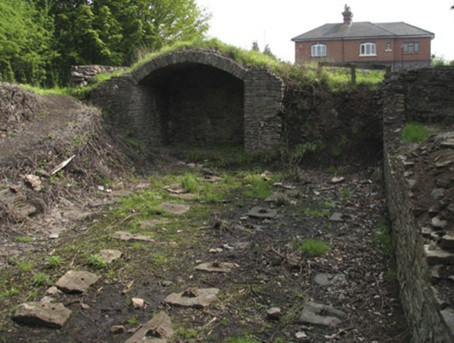
Years ago when researching my paternal family I came upon hitherto unsuspected connections with an ancient industrial history. From that time I became obsessed (not too strong a word) with the lives of coalminers, firstly in the area where my ancestors lived, Oldland in the parish of Bitton, and then expanded exponentially to include the whole of the Kingswood coalfield. A book, ‘Killed in a Coalpit’ researched and revised over many years was the result. There are few tangible remains nowadays where so many tragedies occurred. Ram Hill is an exception.
Making the most of a beautifully sunny Sunday, 19th September 2021, George and I went to the Ram Hill Colliery Open Doors Day at Coalpit Heath. I had read about the site being ‘small and self-contained’ but I didn’t realise quite how small. There is little to see above ground but the compact layout can be easily realised from the excavations. The oval shaped shaft, no longer open of course, was sunk to a depth of 580 feet down which men descended and ascended in a ‘bucket’ or ‘hudge’ suspended on a rope. The workings, contained in a keyhole shaped construction which included the horse gin, was within handy reach of the engine house. The solidly built arch at the end of the dramway, [picture above, still with its rail shoes and stone sleeper blocks] where coal was loaded on to drams or trucks for distribution imperiously dominates the site.
As well as these evocative relics there is a bijou nature trail, and I have to say the wild damsons (fallers) were a delicious bonus. A pity most had been trodden underfoot.
The pit was worked from about 1830 until closure in 1870. It was railway land in 1898 and latterly, the site having fallen into disuse, became a dumping ground for rubbish.
In 1981 it was discovered by the late John Cornwell, the mining historian. When I started my own adventures, he was one of two experts to whom I was introduced, the other being Mathew Southway, the accomplished draughtsman who produced the peerless maps of the coalfield with the wonderful names of our little pits. Perhaps Mat had a hand in the huge chart which covered a wall of John’s study, flagged with the plots of the hundreds of pits which from time immemorial had been dug, exhausted, haphazardly filled in, and then forgotten. [Until, that is, some unsuspecting householder opened their back door one morning, only to be confronted by a yawning hole in the ground!]
When I met John Cornwell in the early 1980s, he recalled the cavalier attitude which prevailed when it came to conserving the documents of coalmining history. With the industry in terminal decline he told me how he had managed to save a few maps and plans from the brazier for which they had been destined, by literally grabbing them out of the flames!
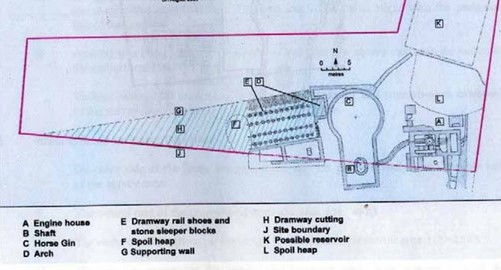
Since that time the Ram Hill site has been fully excavated and mapped. The remains of the shaft top, the dramway terminus, the foundations of the small beam winding engine and the walls of the horse gin, can be seen as in the diagram.
I pitied the poor old nag, clopping round and round, its monotonous two miles an hour kept in check by a small boy with a switch. Yet even this was probably an improvement on the job of the hefty younger bloods which hauled the loaded drams along the rails to their destination. And at the end of it, as for all horses, the knacker’s yard.
I looked up ‘horse gin’ when we got home. It never occurred to me before that ‘gin’ was short for engine. I thought it was something to do with the ‘spinning jenny’ of school history lessons, probably from the fact of the circling!
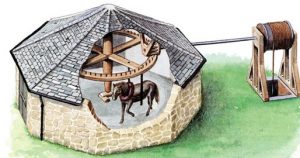
I understand there were about 300 hands employed at Ram Hill. These miners seem rarely to have made the news. The only ones I have been able to find are three who were killed in accidents at the pit, and John Cook who died in May 1877.
People with an interest in the estate of ‘John Cook, deceased’ were sought by solicitors who advertised in the Bristol Mercury on 20th April 1878:
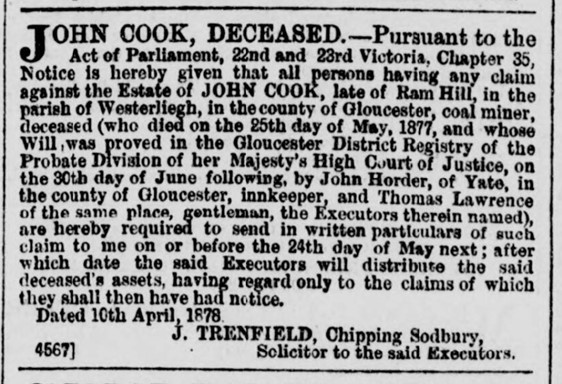
Cook had amassed a tidy little fortune, leaving ‘effects under £600’. It is not easy to assess the worth of this sum today, but certainly amounted to thousands of pounds. The register of deaths [June quarter 1877, Chipping Sodbury] suggests his year of birth was 1808 but without purchasing the death certificate I cannot say more about him owing to the number of John Cooks available in the area, none of whom quite fit.
The fatal accidents at Ram Hill appear in ‘KIACP’:
The first, in 1853, refers to Joseph ELLIOTT, 21. The circumstances of his death were tragically bizarre. Elliott, a coalminer, a married man, was working at a lower vein at Ram Hill when he gave the usual signal to ascend; this was passed by the banksman to the engineer, Isachar Dando, who set the engine in motion. The cart had ascended half way when a drover could be seen coming along the road with a pig Dando had recently purchased at Westerleigh Fair.
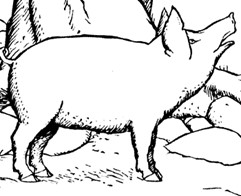 Dando, in some excitement, forgot himself, left his post with his task unfinished and rushed off to see the pig, leaving the machinery to his son, Moses, a youth of eighteen, who had hauled up on several previous occasions. Daniel Flook, a witness, stated that the boy was competent to do the work, but unhappily this time, he panicked when Elliott “whooped” to say he wanted to be drawn up. He muddled the reversing handles by which the speed was increased instead of being slowed down. Elliott was drawn over the shiver wheel and precipitated 59 yards, receiving injuries from which he died.
Dando, in some excitement, forgot himself, left his post with his task unfinished and rushed off to see the pig, leaving the machinery to his son, Moses, a youth of eighteen, who had hauled up on several previous occasions. Daniel Flook, a witness, stated that the boy was competent to do the work, but unhappily this time, he panicked when Elliott “whooped” to say he wanted to be drawn up. He muddled the reversing handles by which the speed was increased instead of being slowed down. Elliott was drawn over the shiver wheel and precipitated 59 yards, receiving injuries from which he died.
The story in a shortened version was used as an illustration by the ‘Friend of Ram Hill’ who took us round. There is more information in the book. The surname Dando is frequent at Westerleigh-Coalpit Heath and I cannot say whether Isachar was closely related to the next named, Job.
The second accident took place in 1855, concerning Job DANDO, 28, & George ROLPH, 24, two colliers employed at No. 2. Ram Hill Pit. They were being hauled up in an iron cart or hudge by means of a rope worked by a steam engine. [The horse was obviously redundant by this time.] Half-way up the shaft the rope came off, and hurtled violently against the axle or drum which broke in pieces. The cart fell 50 fathoms to the bottom. Dando died instantly and Rolph was so badly injured that he expired twenty minutes after being taken to his home. Mr Mackworth, the Government Inspector of Mines, said the rope was “tolerable” but there was an iron clasp or joint in it, which may have been the reason it came off the drum. “A rope with a join in it ought never to be used for drawing men up the pit,” he said. The Coroner addressed all concerned with the management of the pit about their responsibility to keep the machines, ropes and tackle in good order.
At the time of his death Job Dando was a married man with a young family of two daughters and two sons. In the next census, 1861, his widow, nee Mary Hughes, by then 36 years old, working as a “house servant” was living with the four children at Goose Green, Frampton Cotterell. A decade later she was at the same address, a “charwoman”. The two daughters Hannah and Rachel had left home, probably into ‘service’. There is a possibility that in 1871 Rachel was a laundry maid in London, and perhaps was married in Bristol in 1873. Hannah’s job was somewhat superior; she was ‘a lady’s maid’ but by 1881 had returned home, unmarried aged 39, to live with her mother and brothers, George and Job, who had followed in their father’s footsteps. Both men were single and also in their 30s. The pair got into a spot of bother in 1885 when they were arrested for activities during an Election riot at Iron Acton. Job was described as ‘a rough looking fellow’ but those proceedings are a tale for another day.[1] For some time I entertained the idea that Hannah Dando married a colliery engine driver with the glorious name of Hopeful Pullin, but this appears to be the wedding of another Hannah, one of the many local Dandos. In 1901, our Hannah, by then Mrs Knight, a widow, was still with her mother having re-located to Chiphouse Lane, Kingswood. Mary, whose age fluctuated over the years died in the December quarter of 1907, ‘aged 87’.
In 1851, George Rolph, appears to be the coalminer ‘aged 16’ (few people were sure of their ages) who was living at Kendalshire with his father Anthony and mother Ann. His father and younger brother Henry also worked in the mines. In the index report of 7th November 1855 his surname is shown as ‘Ralph’.
This accident caused a furore and is reported in the national as well as local papers.
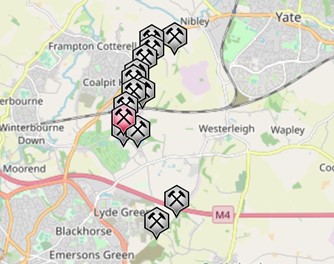
Pits in the vicinity of Frampton Cotterell and Coalpit Heath
It is not easy to identify miners who were living near Ram Hill pit itself. It seems likely that some at least walked to their work from other hamlets. As can be seen in the diagram Ram Hill was part of a complex of about a dozen pits in the area.
References and acknowledgments
As someone who cannot draw for toffee, I am very grateful to those good people who put their diagrams and research on line, and I hope I am not infringing anyone’s copyright.
For a definitive study of Ram Hill colliery, see Roger Gosling’s report ‘Ram Hill: a Case Study of Site Conservation’ in Chapter 6 of ‘Ten Years On’, a publication which came out in March 2012 to celebrate South Gloucestershire Mines Research Group’s first decade of existence:
Please also see Bridget Hetzel’s thesis and the Geophysical survey of 2006.
[1] BT & M, 17.12.1885


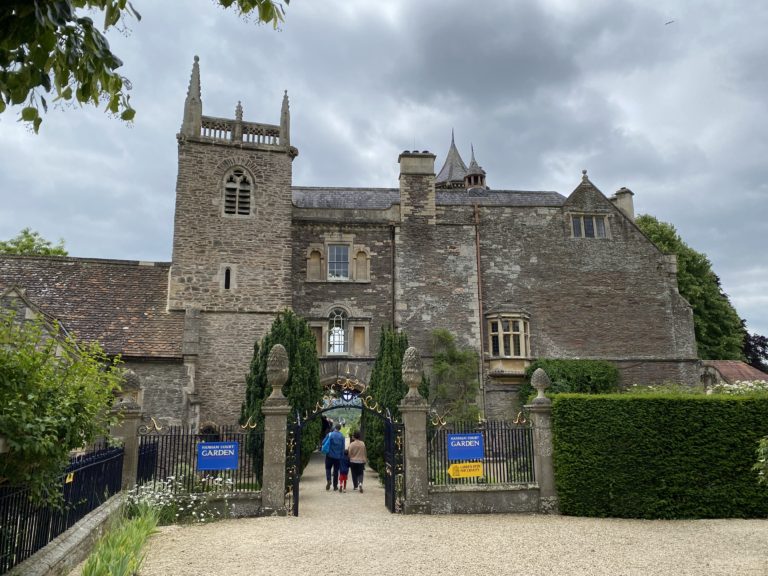
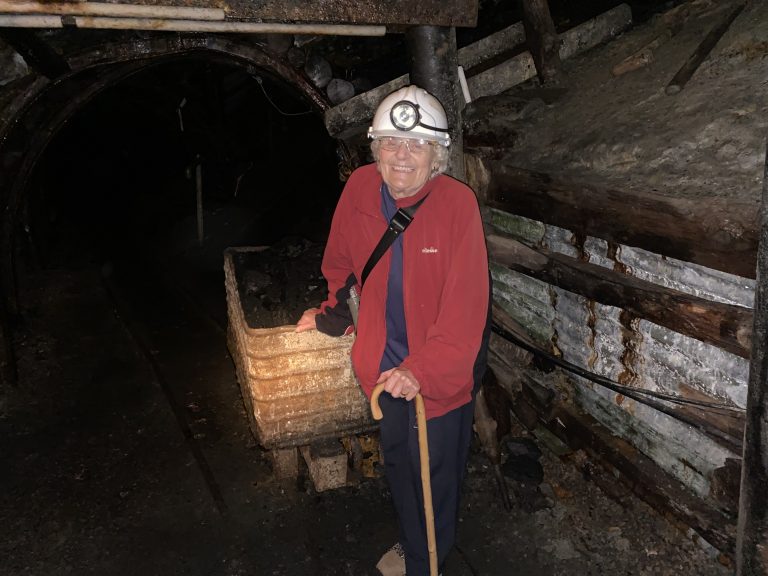






Leave a Comment